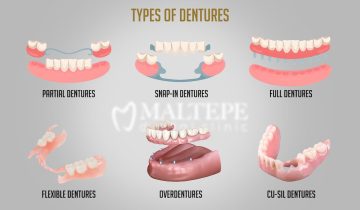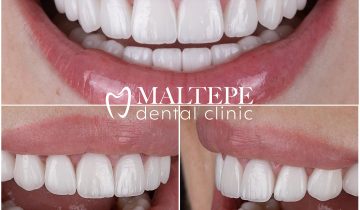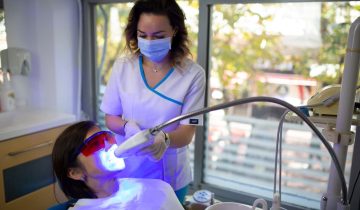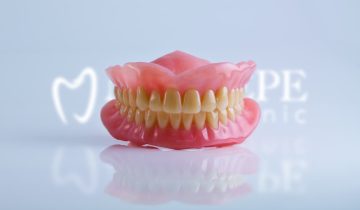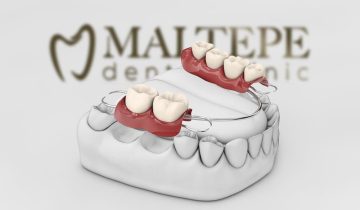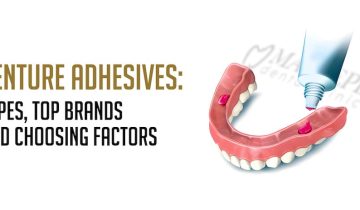Overdenture is a practical dental treatment that is suitable for patients missing some of their teeth. The treatment is also called hybrid prosthesis, tooth-supported dentures, or telescopic dentures. Principally, remaining natural teeth or dental implants support overdentures to give the maximum comfort and functionality.
In this post, you will find a complete guide on overdentures. Starting from the definition and types of overdentures, you will learn about the procedural steps, pros and cons of overdentures, the cost of overdentures, and some alternative treatments that can be compared to overdentures. Finally, you will find a FAQ section in which you can find quick answers to the common questions about overdentures.
What Is An Overdenture?
An overdenture is a type of removable denture resting on the remaining natural teeth, teeth root, or dental implants. Overdentures are dental prostheses used to replace missing natural teeth for particularly edentulous patients. In addition to the aesthetic benefits they bring, overdentures help patients gain perfect functionality which has been lacking for some years. An implant overdenture, also, protects the natural jaw bone structure.
There are various types of overdentures. Basically, overdentures are implant-supported or tooth-supported. However, it is possible to categorize them according to other properties. If you are overwhelmed with this issue, the following table can make your mind clear.
| Types of overdentures | ||
| Abutment types | Location in mouth | Attachment types |
| Implant-supported overdentures | Maxillary (upper jaw) overdentures | Stud |
| Tooth-supported overdentures | Mandibular (lower jaw) overdentures | Magnet |
| Bar | ||
Implant Supported Overdentures
Implant-supported overdentures are supported by dental implants and are ideal for edentulous patients with a sufficient amount of ridge bone. They provide high stability and aesthetic beauty. Dentists can use different attachment techniques depending on the case.
Tooth-Supported Overdentures
Tooth-supported overdentures are supported by remaining natural teeth or teeth roots. Preventing the resorption of the residual ridge, they offer stability and long-lasting functionality. Some rigid or non-rigid techniques can be used to attach tooth-supported overdentures.
Maxillary (Upper Jaw) Overdentures
Maxillary overdentures are attached to the upper jaw. They are usually attached to the maxillary arch using dental implants of 4. If the patient has enough number of teeth remaining, the tooth-supported overdenture technique can be used, too.
Mandibular (Lower Jaw) Overdenture
Mandibular overdentures are supported by natural teeth or dental implants, and they are used for the lower arch of the mouth. For implant-supported mandibular overdentures, dentists usually use 4 implants to provide the best support and stability.
Stud Attachment
Stud precision attachments, also called ball-retained overdentures, are commonly used for removable overdentures. They have male and female components. The two components are attached, and they provide stability and retention. Parallel stud attachments allow patients and dentists to remove dentures easily.
Magnetic Attachment
Magnet attachments are used to secure the holding between the overdenture and implants. Magnetic attachments do not require abutment parallelism, and thus they can be a better option in some cases.
Bar-Retained Overdenture
Bar-retained overdentures make use of a bar between the implants. The denture is clipped onto the bar, and it provides a strong retention. Bars provide higher security than a traditional denture as well as allowing easy removal.
What Are The Implant Overdenture Steps?
The steps to implant overdentures are as follows:
Step 1: Initial Consultation
The dentist examines whether you are a good candidate for implants and overdentures. To this end, they take the impressions of your jaws and remaining teeth (if any). If you don’t have enough ridge bone, you might need a bone grafting treatment before moving on to the next step.
Step 2: Implant Placement
They give local anesthesia and place the implants. Then, you need to wait for the implants to fuse with the jawbone. It usually takes 3-5 months for the implant and bone structure to fuse.
Step 3: Abutment Placement
Abutments are tiny posts protruding from gums to serve as a base for the overdentures to come. When the implants are fused with jawbones, the dentist places the abutments.
Step 4: Taking Impressions
Your dentist needs to take impressions of your mouth to prepare a custom-made overdenture for you. Impressions are sent to the laboratory, and technicians manufacture the perfect overdenture for you.
Step 5: Fitting And Alignment
Once your overdenture is ready, the dentist attaches it to the implant abutments and does the final fitting and alignment. Your denture should fit your mouth strongly and comfortably.
Step 6: Follow-up Visit
Your dentist arranges an appointment to see if your implant-supported overdenture works properly.
What Are The Pros Of Overdenture?
Overdentures offer you the following advantages:
- Natural-looking and comfortable replacement
- Better nutrition with increased biting and chewing performance.
- Enhanced support for jawbone without sunken look.
- Simple maintenance requirement.
- Lasting solution.
What Are The Cons Of Overdenture?
Overdentures might not be the best option for some patients due to one or more of the following reasons:
- Implants (for implant-supported overdentures) require healthy bones and gums.
- The procedure usually takes several months.
- The cost of the treatment might be too expensive especially if your insurance doesn’t fully cover it.
What Are Complications Of Over Denture?
According to a study, published in Medical Science Monitor in 2017, the most common complications of implant supported prosthesis were:
- loss of retention
- mucositis
- abutment screw loosening
- fracture
What Is The Cost Of Overdenture?
Bunun cevabını mutlaka rakam ile verelim. yukarıdaki type ların fiyatları farklı ise her biri için bir fiyat aralığı verebiliriz madde madde. Gerekirse klinikten fiyat sorabiliriz. aşağıdaki linkte cevap güzel. per arc şeklinde biz de verebiliriz https://www.newmouth.com/dentistry/restorative/dentures/overdenture/
What Is The Difference Between A Denture And An Overdenture?
Overdentures come with improved functionality and stability compared to traditional dentures. Therefore, overdentures result in higher patient satisfaction.
What Is The Difference Between Hybrid Denture And Overdenture?
The table below illustrates the key differences between hybrid dentures and overdentures.
| Hybrid Denture(also called as All-on-4® or All-On-6®) | Overdentures |
| Fixed | Removable or fixed |
| Full arch replacement | Full or partial replacement |
| More expensive | Less expensive |
| Higher biting and chewing performance | Slightly less biting and chewing performance |
| Better sense of taste | Relatively lower sense of taste |
What Teeth Are Best For Overdentures?
Overdentures can replace full arch, but especially for partial overdentures, the teeth with the most solid roots are the best such as canines and molars.
What Are The Alternatives Of Overdenture?
The alternatives for overdentures can be dental implants or bridges.
FAQs About Overdenture
Here are the short answers to the most common questions about overdentures:
How Long Do Overdentures Last?
According to a review article published in the Journal of Advanced Prosthodontics in 2012, the survival rate of the overdentures varied between 91% and 100% over the duration ranging from 1 year to 10 years.
How Do I Care For An Overdenture?
- Remove your denture daily and clean it daily.
- Use non-scented antibacterial soap and water for cleaning.
- Scrub it gently to make sure there are no food particles left.
- Let it stay in clean water overnight.
- You can add a denture cleaning table to the water once or twice a week.
- In the morning, brush your gum tissue, abutments, and tongue decently.
- Put your overdenture carefully.
Are Overdentures Removable?
There are removable and fixed overdentures.
Can You Wear Dentures Full Time?
Wearing dentures full-time is not advised. Your gum tissue needs to contact with fresh air, and your dentures need to be cleaned. Otherwise, you might suffer from irritation or swelling in your gums.

